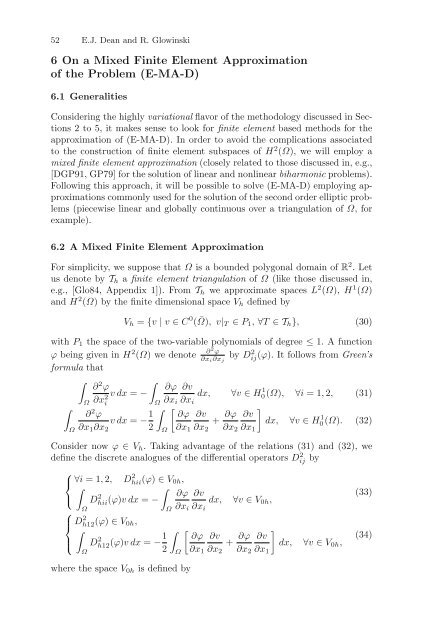Partial Differential Equations - Modelling and ... - ResearchGate
Partial Differential Equations - Modelling and ... - ResearchGate
Partial Differential Equations - Modelling and ... - ResearchGate
Create successful ePaper yourself
Turn your PDF publications into a flip-book with our unique Google optimized e-Paper software.
52 E.J. Dean <strong>and</strong> R. Glowinski<br />
6 On a Mixed Finite Element Approximation<br />
of the Problem (E-MA-D)<br />
6.1 Generalities<br />
Considering the highly variational flavor of the methodology discussed in Sections<br />
2 to 5, it makes sense to look for finite element based methods for the<br />
approximation of (E-MA-D). In order to avoid the complications associated<br />
to the construction of finite element subspaces of H 2 (Ω), we will employ a<br />
mixed finite element approximation (closely related to those discussed in, e.g.,<br />
[DGP91, GP79] for the solution of linear <strong>and</strong> nonlinear biharmonic problems).<br />
Following this approach, it will be possible to solve (E-MA-D) employing approximations<br />
commonly used for the solution of the second order elliptic problems<br />
(piecewise linear <strong>and</strong> globally continuous over a triangulation of Ω, for<br />
example).<br />
6.2 A Mixed Finite Element Approximation<br />
For simplicity, we suppose that Ω is a bounded polygonal domain of R 2 .Let<br />
us denote by T h a finite element triangulation of Ω (like those discussed in,<br />
e.g., [Glo84, Appendix 1]). From T h we approximate spaces L 2 (Ω), H 1 (Ω)<br />
<strong>and</strong> H 2 (Ω) by the finite dimensional space V h defined by<br />
V h = {v | v ∈ C 0 ( ¯Ω), v| T ∈ P 1 , ∀T ∈T h }, (30)<br />
with P 1 the space of the two-variable polynomials of degree ≤ 1. A function<br />
ϕ being given in H 2 ∂<br />
(Ω) wedenote<br />
2 ϕ<br />
∂x i∂x j<br />
by Dij 2 (ϕ). It follows from Green’s<br />
formula that<br />
∫<br />
∂ 2 ∫<br />
ϕ<br />
∂ϕ ∂v<br />
Ω ∂x 2 vdx= −<br />
dx, ∀v ∈ H0 1 (Ω), ∀i =1, 2, (31)<br />
i<br />
Ω ∂x i ∂x i<br />
∫<br />
∂ 2 ϕ<br />
vdx= − 1 ∫ [ ∂ϕ ∂v<br />
+ ∂ϕ ]<br />
∂v<br />
dx, ∀v ∈ H0 1 (Ω). (32)<br />
Ω ∂x 1 ∂x 2 2 Ω ∂x 1 ∂x 2 ∂x 2 ∂x 1<br />
Consider now ϕ ∈ V h . Taking advantage of the relations (31) <strong>and</strong> (32), we<br />
define the discrete analogues of the differential operators Dij 2 by<br />
⎧<br />
⎨ ∀i =1, 2, Dhii(ϕ) 2 ∈ V 0h ,<br />
∫<br />
∫<br />
⎩ Dhii(ϕ)vdx= 2 ∂ϕ ∂v<br />
(33)<br />
−<br />
dx, ∀v ∈ V 0h ,<br />
∂x i ∂x i<br />
⎧<br />
⎪⎨<br />
⎪⎩<br />
Ω<br />
D 2 h12(ϕ) ∈ V 0h ,<br />
∫<br />
Ω<br />
D 2 h12(ϕ)vdx= − 1 2<br />
where the space V 0h is defined by<br />
Ω<br />
∫<br />
Ω<br />
[ ∂ϕ<br />
∂x 1<br />
∂v<br />
+ ∂ϕ ]<br />
∂v<br />
dx, ∀v ∈ V 0h ,<br />
∂x 2 ∂x 2 ∂x 1<br />
(34)
















